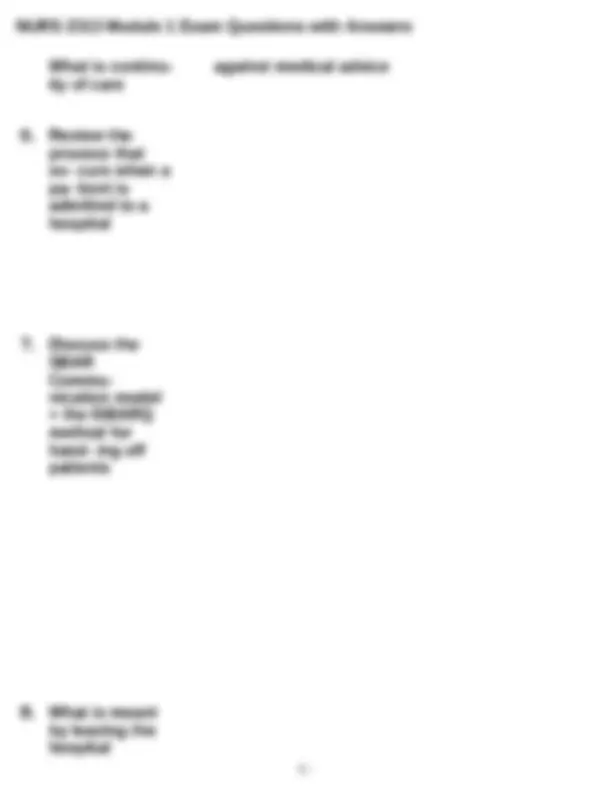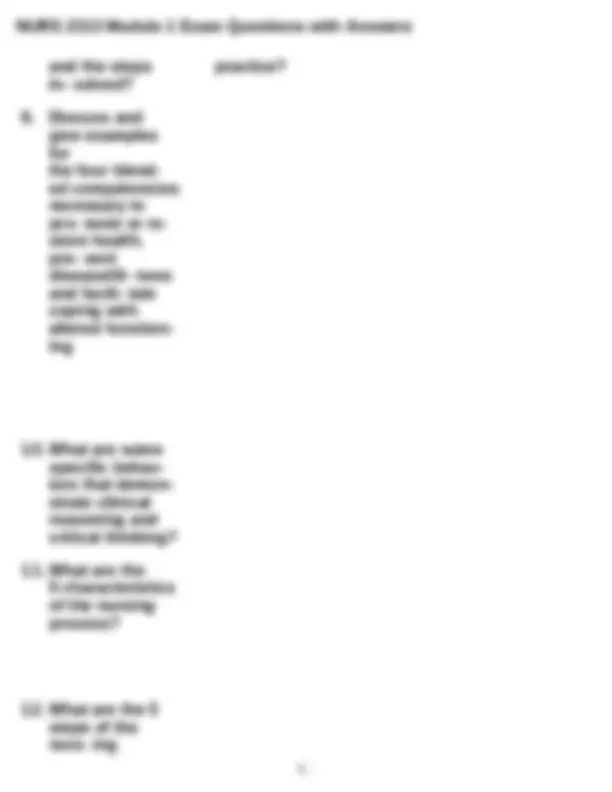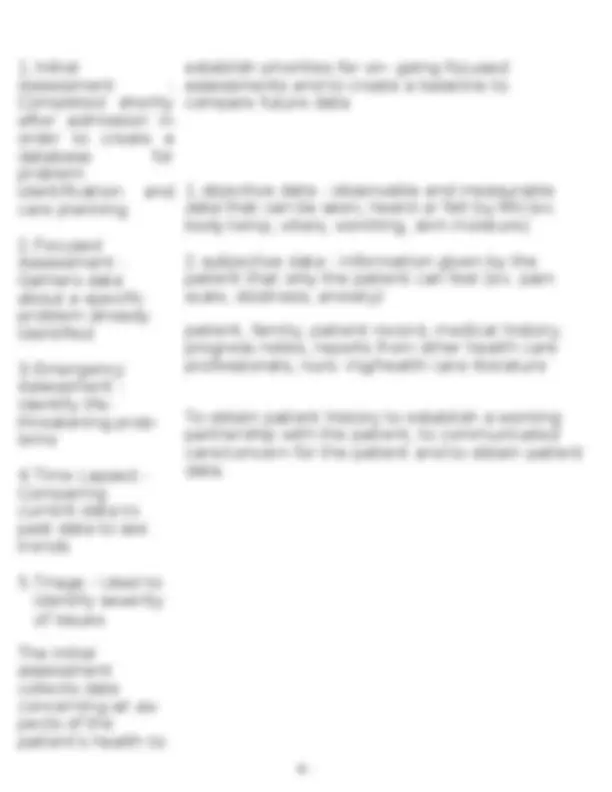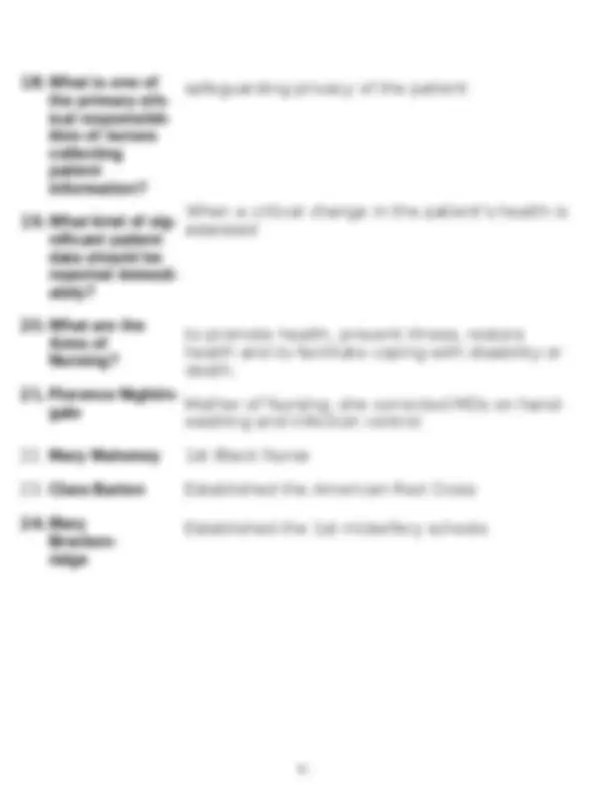Download NURS 2313 Module 1 Exam Questions with Answers and more Exams Nursing in PDF only on Docsity!
1. What are the 8 nursing **roles?
- Discuss the crit-** ical nursing is- sues of the new **millennium
- Develop exam-** ples of needs as that relate to each level of Maslow's Hierar- **chy of Needs
- Describe the lev-** els of health care and the services provided at each level
- Communicator
- Caregiver
- Collaborator
- Counselor, 5.Teacher
- Leader
- Researcher
- Advocate C o s t o f h e a l t h c a r e A l t e r n a t i v e therapies Technology adaptations Impacts of health policy and regulations Physiologic - Oxygen, Nutrition, Fluids, Body temperature, Elimination/voiding, shelter Safety & Security - Fall risk Love & Belonging - isolation requirements could lead to feeling alone Self Esteem - diagnosis could change the patient's role in their own life or home life Self Actualization - a patient accepting a diagnosis & moving forward with treatment Primary - promoting health & preventing disease (immu- nization clinics, education on healthy behaviors/habits) Secondary - screening for early detection (child growth + development screening, women's health screening such as pap smear, regular dental/vision check-ups) Tertiary - treatment after a diagnosis (treating COPD, Di- abetes, CHF, etc.)
ensures a smooth transition between acute hospital care and ambulatory outpatient care or home health/other com- munity health care settings Admitting office obtains information about the patient, completes admissions forms and provides patient identifi- cation wristband Room preparation
- RN role to ensure inventory of patient personal items Admit to unit - admit assessment , medication reconcilia- tion form + the nurse should welcome the patient to the unit and provide care of needs. SBAR is used to transfer responsibility of the patient to the next shift's RN I- introduction : identify the roles of the health care profes- sionals involved in hand off S- Situation : Give specifics about the patients chief com- plaints, diagnosis, treatment plan, as well as the patients wants/needs B- Background : Give background on the patient such as vitals, mental status, code status, medications, lab results, etc. A- Assessment : Discuss the providers assessment of the patient R- Recommendations : Give any recs of what needs to be done next as part of the patient's care plan and interven- tions Q- Questions : Leave time for an opportunity for questions in answers in the handoff to the next RN The patient is able to leave AMA at any time during care but they must sign a release form being informed of the risks with leaving against medical advice prior to actually leaving. The patient's signature must be witnessed and the form is a part of the patient's medical record.
and the steps in- volved?
9. Discuss and give examples for the four blend- ed competencies necessary to pro- mote or re- store health, pre- vent disease/ill- ness and facili- tate coping with altered function- ing 10.What are some specific behav- iors that demon- strate clinical reasoning and critical thinking? 11.What are the 5 characteristics of the nursing process? 12.What are the 5 steps of the nurs- ing practice?
13.Describe the 5 types of nurs- ing assessments and their pur- pose 14.What are the re- sults of the ini- tial comprehen- sive nursing as- sessment & what does it tell the nurse? 15.Differentiate be- tween the 2 types of data and pro- vide examples of both types 16.What are some sources of pa- tient data useful to the nurse? 17.How and why are nursing inter- views conduct- ed?
- Initial Assessment : Completed shortly after admission in order to create a database for problem identification and care planning
- Focused Assessment : Gathers data about a specific problem already identified 3.Emergency Assessment : Identify life- threatening prob- lems 4.Time Lapsed - Comparing current data to past data to see trends 5.Triage - Used to identify severity of issues The initial assessment collects date concerning all as- pects of the patient's health to establish priorities for on- going focused assessments and to create a baseline to compare future data
- objective data - observable and measurable data that can be seen, heard or felt by RN (ex. body temp, vitals, vomiting, skin moisture)
- subjective data - information given by the patient that only the patient can feel (ex. pain scale, dizziness, anxiety) patient, family, patient record, medical history, progress notes, reports from other health care professionals, nurs- ing/health care literature To obtain patient history to establish a working partnership with the patient, to communicated care/concern for the patient and to obtain patient data.


















